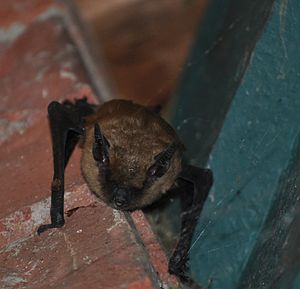California mouse-eared mouse
| California mouse-eared mouse | ||||||||||||
|---|---|---|---|---|---|---|---|---|---|---|---|---|

Californian mouse-eared mouse ( Myotis californicus ) |
||||||||||||
| Systematics | ||||||||||||
|
||||||||||||
| Scientific name | ||||||||||||
| Myotis californicus | ||||||||||||
| Audubon & Bachman , 1842 |
The Californian mouse- eared bat ( Myotis californicus ) is a bat species from the smooth-nosed family (Vespertilionidae), which is native to North America.
description
The California mouse- eared bat is a small bat with an overall length of 74 to 95 mm, a forearm length of 32 to 35 mm, and a weight of 3.3 to 5.4 g. the wingspan averages 242 mm. It has relatively slender, small feet that are less than half the length of the tibia . The Kalkar is thin and strongly curved. The California mouse ear differs from the sympatric occurring western small-footed bat by a more rounded skull and a narrower snout, and by the pattern of hair that cover the muzzle. Seen from above, the bare part of the California mouse-eared snout is only as long as the diameter of the nostrils, in contrast to M. ciliolabrum , where the hairless part is 1.5 times as long. The Californian mouse-ear differs from Myotis findleyi by the black mask, ears and claws and the reddish color of the fur. The California mouse -eared bat has shorter feet than the Yuma bat ( Myotis yumanensis ) and a hairless tail- flight membrane .
Way of life
The California mouse-eared mouse, like most bats, is nocturnal and feeds on insects, with butterflies and two-winged birds being preferred. Furthermore, beetles , beaked beetles and caddis flies belong to the prey animals. While the Californian mouse-eared mouse mostly hunts over or near water, M. ciliolabrum usually looks for its prey near rocks, so that the two species do not compete for food in areas where they occur together. During the day, the California mouse-eared mouse hangs alone or in small groups in crevices, under bark or in buildings. The animals hibernate during the cold season . Female specimens give birth to a single young animal per year and litter. Bats of this species can probably live to be over 15 years.
distribution and habitat
The California mouse-eared mouse is found west of the Rocky Mountains from Canada to Mexico . Thanks to its widespread distribution, the IUCN has classified its population as stable and the species as safe.
literature
- MR Simpson (1993): Myotis californicus . In: Mammalian Species , No. 428, pp. 1-4